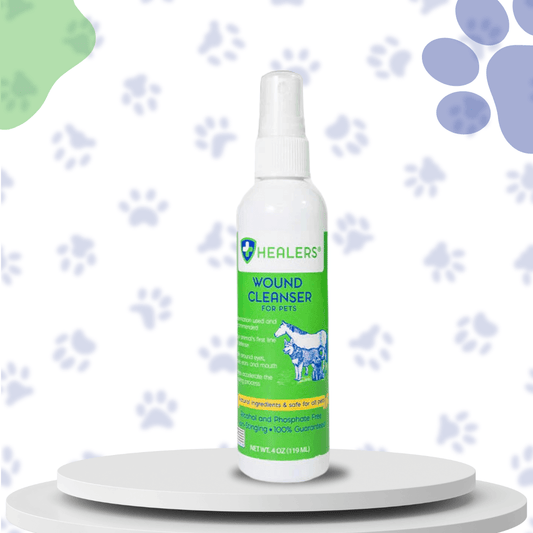A Guide To Dog Anxiety, Signs & Treatments
Share
Dogs can experience varying degrees of anxiety in much the same way as humans do. As we know, manageable amounts of anxiety that we experience in context to the circumstances can be a perfectly healthy, normal emotion to have.
Sometimes, however, anxiety can become a debilitating disorder, and disproportionate levels of anxiety can be suffered that require treatment. Anxiety can be experienced by any and all canine breeds, although each dog is individual in the way that it may affect their behaviors. When anxiety in dogs goes untreated, the risks of associated behavioral and other issues increase significantly, so it’s important to know what to look out for and what course of action to take.

What causes anxiety in dogs?
There are a number of reasons for anxiety in dogs, but they typically fall into one of three main categories. These are:
Separation anxiety
This type of anxiety stems from a dog’s discomfort with being left alone, or separated from their familiar family/household members. It can be difficult for dogs with separation anxiety to soothe themselves, and instead, problematic behaviors often ensue. These can range from incessant barking and whining, to destroying furniture and urinating or even defecating in the house when left alone, particularly for longer periods of time.
Fear-related anxiety
Some dogs respond fearfully to certain stimuli, such as sudden loud noises from chainsaws or fireworks, other animals or unfamiliar people, new or unusual environments, or unfamiliar items, like umbrellas. For some dogs, car rides are particularly uncomfortable, and the veterinary clinic can understandably cause a rise in anxiety.
Many dogs have some level of reaction to such stimuli, but in particularly anxious dogs, the reactions can be more substantial and longer lasting.
Age-related anxiety
When dogs age, they can experience cognitive dysfunction syndrome (CDS), which can, in turn, create feelings of anxiety. CDS can affect their perception, memory and general circumstantial and environmental awareness, and is often comparable to the onset of Alzheimer's in humans. Not surprisingly, this condition can lead to feelings of confusion and resulting anxiety for older dogs.
What are the signs of anxiety in dogs?
Some of the most common signs and symptoms to look out for include:
- Panting
- Drooling
- Pacing
- Restlessness
- Incessant barking
- Destructive behavior
- Aggression
- Urinating or defecating in inappropriate places
- Compulsive (repetitive behaviors)
- Depression, low energy and flat mood
Sometimes, dogs exhibit these anxiety symptoms only occasionally, and if the triggering stimuli is uncommon to encounter and the reaction is manageable, then no action is necessarily required.
Aggressive reactions require attention for obvious reasons, as they can lead to harm being caused to other animals or humans and must be addressed.
Destructive behaviors are common with separation anxiety, in particular, as well as inappropriate urination and defecation in the house while left alone. Even dogs that are well house-trained can become so anxious that they cannot control their bodily functions. Destructive behaviors are often focused around exit points such as doors and windows, as the anxious dog attempts to escape the confines and seek to reunite with their pack.
How is anxiety in dogs treated?
The first step in assessing how best to treat and manage your dog’s anxiety is to consult with your veterinarian. They will be able to help in identifying the nature of your dog’s anxiety, as well as the particular triggers that worsen it. A vet can also assess whether the anxiety is purely situational, or if it has become a significant underlying condition that affects your dog in a more general sense. It is also important to assess whether their diet or current medications could be contributing to the issue.
From there, you can formulate a treatment plan. It is common for this to take the form of a multi-layered approach, such as a combination of prevention, training, and possibly medications. Looking at their diet and considering whether supplementation could help is an important factor, too.
Counterconditioning and training
Counterconditioning seeks to alter the dog’s response to the anxiety-evoking stimuli, and often involves simultaneously introducing pattern-interrupting stimuli when exposed to the triggering one. When sufficiently repeated, this can condition the dog to adopt a more favorable response.
Another common training strategy used is desensitization. In this case, the dog is gradually introduced to the trigger while positively reinforcing any calm reactions. The dog is exposed to the anxiety trigger in small, manageable amounts that gradually increase in intensity to desensitize them. It may be necessary to consult with a professional dog trainer when attempting to carry out these approaches, as anxious dogs can be difficult to work with.
Medications for anxious dogs
If your dog’s anxiety disorder is severe enough, a vet may determine that it is necessary to treat it with medication, such as an SSRI or other antidepressant. They may also prescribe a benzodiazepine to use for occasional events that heighten their anxiety further, such as during thunderstorms.
For senior dogs suffering with CDS, it may be beneficial to treat them with a medication called selegiline, which helps to reduce some of the CDS symptoms and can therefore inadvertently treat their anxiety.
Some dog owners report that using CBD oil helps in treating their pet’s anxiety, although no scientific data currently exists to clarify these claims. You can discuss this option with your vet.
Final thoughts
Aside from recognizing and treating your dog’s anxiety as outlined above, there are some other preventative measures you can take to assist them further. Learning how to read their body language to address the onset of anxiety sooner can be helpful, as well as ensuring that their diet is optimal and that they are well socialized. Busy lives can make it difficult to limit their time alone, but where possible try to keep it to a minimum.
Guest Blogger: Howie Robleza





